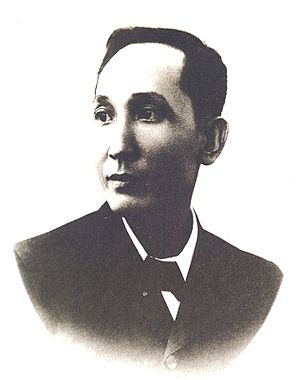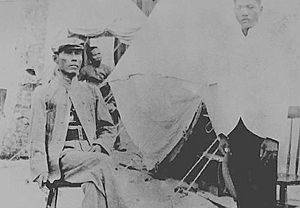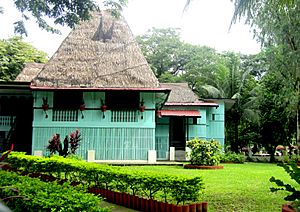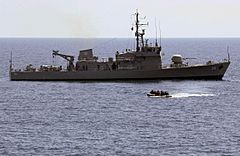Apolinario Mabini facts for kids
Quick facts for kids
Excelentísimo Señor
Apolinario Mabini
|
|
|---|---|
 |
|
| 1st Prime Minister of the Philippines | |
| In office January 23, 1899 – May 7, 1899 |
|
| President | Emilio Aguinaldo |
| Preceded by | Office established |
| Succeeded by | Pedro Paterno |
| 1st Secretary of Foreign Relations | |
| In office January 23, 1899 – May 7, 1899 |
|
| Preceded by | Position established |
| Succeeded by | Felipe Buencamino |
| Personal details | |
| Born |
Apolinario Mabini y Maranan
July 23, 1864 Barrio Talaga, Tanauan, Batangas, Captaincy General of the Philippines, Spanish Empire |
| Died | May 13, 1903 (aged 38) Manila, Philippine Islands |
| Alma mater | Colegio de San Juan de Letran University of Santo Tomas |
| Profession | Politician, lawyer |
| Signature | |
Apolinario Mabini y Maranan (Tagalog: [apolɪˈnaɾ.jo maˈbinɪ], July 23, 1864 – May 13, 1903) was a very important Filipino leader. He was a lawyer, teacher, and politician. He served as a top adviser to the Revolutionary Government. Later, he became the first Prime Minister of the Philippines when the First Philippine Republic was formed.
People called him the "utak ng himagsikan" or "brain of the revolution." He is also known as a national hero. Mabini's ideas greatly shaped the Philippines' fight for freedom.
He wrote two important works: El Verdadero Decálogo (The True Decalogue, June 24, 1898) and Programa Constitucional de la República Filipina (The Constitutional Program of the Philippine Republic, 1898). These writings helped create the Malolos Constitution, which was like the first constitution for the Philippines.
Mabini did all his important work even though he lost the use of his legs. This happened because of a disease called polio just before the Philippine Revolution began in 1896.
Mabini fought against Spanish rule at the start of the revolution. Later, he faced American rule during the Philippine–American War. The Americans captured him and sent him away to Guam. He was allowed to return only two months before he passed away in May 1903.
Contents
Who Was Apolinario Mabini?
His Early Life and School Days
Apolinario Mabini was born on July 23, 1864. His birthplace was Barrio Talaga in Tanauan, Batangas. He was the second of eight children. His mother, Dionisia Maranan y Magpantay, sold goods in the market. His father, Inocencio Leon Mabini y Lira, was a farmer who could not read or write.
Apolinario Mabini went to a special school run by Father Valerio Malabanan in Lipa. His family was poor, but he could attend because the school accepted students based on how smart they were, not how much money their parents had. While studying in Lipa, he met Miguel Malvar, who would also become a future leader.
In 1881, Mabini received a scholarship. This allowed him to study at Colegio de San Juan de Letran in Manila. There's a story that a professor tried to embarrass him because he looked poor. But Mabini surprised everyone by answering very difficult questions easily. He often had to stop his studies because he ran out of money. To earn money, he taught children.
Becoming a Lawyer
Mabini's mother wanted him to become a priest. However, he wanted to help poor people, so he decided to study law instead. He earned his first degree, a Bachelor of Arts, with top honors. He also became a Professor of Latin from Letran.
A year later, he went to the University of Santo Tomas. He earned his law degree in 1894.
A famous writer, Nick Joaquin, compared Mabini's generation of Filipino thinkers to an earlier group, like Jose Rizal. Joaquin said that Mabini's generation showed that Filipinos could learn and lead their country even with education only from the Philippines. They didn't need to study in Europe anymore.
After graduating, Mabini joined the Guild of Lawyers. But he did not open his own law office. Instead, he continued to work in a notary public's office.
Mabini used his legal knowledge a lot during the Philippine Revolution. He also used it during the Filipino-American War. Joaquin noted that all his important contributions involved the law. He was interested in law as a way to achieve fairness and justice.
Joining the Revolution
Freemasonry and La Liga Filipina
Mabini joined a group called Freemasonry in September 1892. He used the name "Katabay." The next year, Mabini became a member of La Liga Filipina. This group was restarting after its founder, José Rizal, was arrested in 1892. Mabini became the secretary of its new Supreme Council. This was the first time Mabini joined a group focused on patriotism.
Mabini believed in making changes through peaceful means. He wanted La Liga Filipina to keep supporting a newspaper called La Solidaridad. This newspaper pushed for reforms from Spain.
Some members of the Liga wanted a more direct revolution. They felt peaceful changes were not working. So, La Liga Filipina split into two groups. One group, the Cuerpo de Compromisarios, wanted to keep supporting reforms. The other group, the Katipunan, wanted a full revolution. Mabini joined the Cuerpo de Compromisarios.
However, when José Rizal was executed in December 1896, Mabini changed his mind. He then fully supported the revolution.
His Illness and Arrest
Mabini became sick with polio in 1895. The disease slowly made him unable to move his legs. By January 1896, he could no longer use either of his legs.
When the Spanish authorities found out about the Katipunan's plans, the Philippine Revolution of 1896 began. Mabini, still sick, was arrested along with other members of La Liga Filipina.
Thirteen patriots in Cavite were arrested, tried, and executed. They are known as the "Thirteen Martyrs of Cavite." José Rizal was also accused of being part of the revolution and was executed later that year. However, when the Spanish authorities saw that Mabini was paralyzed, they decided to release him.
Adviser to the Revolutionary Government
After his arrest, Mabini was sent to the hospital. He remained in poor health for a long time. In 1898, he was resting at the hot springs in Los Baños, Laguna. That's when Emilio Aguinaldo sent for him. Aguinaldo asked Mabini to become an adviser to the revolution.
During this time, Mabini wrote two important pamphlets: "El Verdadero Decálogo" and "Ordenanzas de la Revolución." Aguinaldo was very impressed by these writings. He was also impressed by Mabini's role in La Liga Filipina. So, Aguinaldo arranged for Mabini to be brought from Los Baños to Kawit, Cavite. It took hundreds of men to carry Mabini in his hammock all the way to Kawit.
Mabini continued to be the main adviser for General Aguinaldo. This was after the Philippine Declaration of Independence on June 12, 1898. He wrote many official orders and helped edit the Malolos Constitution. This constitution set up the government for the First Philippine Republic in Malolos in 1899.
First Prime Minister
After Aguinaldo returned to the Philippines from Hong Kong in May 1898, he asked Mabini to help him create a government. Mabini wrote the decree on June 18, 1898, which set up the Dictatorial Government of the Philippines. On January 21, 1899, the Malolos Constitution was officially announced. This was the main law for the First Philippine Republic. Mabini was then chosen as the Prime Minister and also the Foreign Minister. He led the first group of government leaders, called the cabinet, for the new republic.
Mabini was at the center of a very difficult time for the new country. He had to deal with many unexpected problems. One of the biggest challenges was negotiating with the Americans. These talks started on March 6, 1899. The United States and the Philippine Republic were having very strong disagreements, which soon turned into fighting. During peace talks, the Americans offered Mabini some self-rule for Aguinaldo's government. But the talks failed because Mabini wanted a ceasefire, which the Americans refused. Mabini tried again, asking for a temporary stop to the fighting (an armistice). But these talks also failed. Finally, Mabini felt the Americans were not serious about peace. He decided to support the war and resigned from the government on May 7, 1899.
War, Exile, and Return
During the Philippine–American War, the Americans saw Mabini as a bigger threat than the Spanish had. A Filipino writer, F. Sionil Jose, said that the Spanish did not take Mabini seriously because he was paralyzed. But the Americans knew how smart he was and how determined he was in talks.
On December 10, 1899, American soldiers captured Mabini in Cuyapo, Nueva Ecija. He was put in prison, even though he was very sick. He was later sent away to the island of Guam. This happened because he refused to promise loyalty to the United States. Other Filipino revolutionaries, called insurrectos (rebels) or Irreconcilables by the Americans, were also exiled.
Mabini returned to the Philippines on February 26, 1903. He agreed to take the Oath of Allegiance to the United States. However, American officials were not happy. Soon after returning, Mabini continued to push for the Philippines to become independent.
His Death
Not long after coming back, Mabini died on May 13, 1903. He was only 38 years old. He died of cholera at his home in Manila. This happened after he drank milk from a carabao that was not treated and was contaminated. About 8,000 people attended his funeral at the Binondo Church.
How We Remember Mabini
Mabini's important contributions are often remembered by two nicknames: "Brains of the Revolution" and "Sublime Paralytic." However, historians like Ambeth Ocampo say these nicknames are too simple. They do not fully show how important Mabini's life and work were.
"Brains of the Revolution"
Mabini is often called the "Brains of the Revolution." This is because he advised the revolutionary government as it was being formed. He also made many important contributions as a statesman. Sometimes, Emilio Jacinto is also called the "Brains of the Revolution." Jacinto played a similar role for an earlier revolutionary group, the Katipunan.
"Sublime Paralytic"
Mabini is also famous for achieving so much despite losing the use of his legs. This happened just before the Philippine revolution. Because of this, Mabini is one of the most recognizable national heroes in the Philippines. He is often called "The Sublime Paralytic" (Tagalog: Dakilang Lumpo).
Tributes to Mabini
Shrines and Monuments
- Two places connected to Mabini have shrines in his honor:
- The house where Mabini died is now on the campus of the Polytechnic University of the Philippines (PUP) in Santa Mesa, Manila. It was moved twice to get there. The simple house still has his original furniture and some of his books. It also has a library and reading areas.
- Mabini was buried in his hometown, which is now Barangay Talaga, Tanauan City, Batangas. An interactive museum was built there. It has historical items, his personal belongings, and his books. It also shares information about Mabini and the Philippines during his time. A copy of the house where Mabini was born was also built at this site.
- Two monuments honor Mabini and 41 other Filipino revolutionaries. They were imprisoned in Agat, Guam. These monuments are at the site of their prison camp, which is now part of the War in the Pacific National Historical Park.
Places Named After Him
- Four towns in the Philippines are named after Mabini:
- Mabini, Batangas,
- Mabini, Bohol,
- Mabini, Davao de Oro, and
- Mabini, Pangasinan
- The main campus of the Polytechnic University of the Philippines (PUP) in Santa Mesa, Manila is named after Apolinario Mabini.
- The Mabini Academy is a school in Lipa City, Batangas. Its logo features Mabini's image.
- The Southern Tagalog Arterial Road, also called the Apolinario Mabini Superhighway, is an expressway. It connects Batangas province to the SLEX.
- Mabini Bridge, in Manila, was renamed in his honor. It was formerly known as Nagtahan Bridge.
- Mabini reef, also called Johnson South Reef, is a reef in the Spratly Islands. The Philippines claims it, but China controls it. Other countries also claim ownership of it.
- A ship in the Philippine Navy, the Jacinto class corvette, BRP Apolinario Mabini (PS-36), is named after Mabini.
Philippine Peso
- Mabini's face is on the Philippine ten peso coin. It used to be with Andrés Bonifacio.
- The newer coins (New Generation Currency Series) only show Mabini.
- He was also on the ten peso bill. This bill was printed from 1972 until 2001. From 1972 to 1997, he was the only person on the front of the banknote. From 1997 to 2001, Andrés Bonifacio was added alongside him.
Mabini in Media
- In the 2015 film Heneral Luna, actor Epi Quizon played Mabini.
- After the movie became popular, some young students asked why Mabini just sat in a chair. This showed they didn't know he was paralyzed. Even President Benigno Aquino III commented on this. He said it showed how little some young people knew about history.
His Writings
- The True Decalogue (El Verdadero Decalogo, June 24, 1898)
- Ordenanzas de la Revolucion
- The Constitutional Program of the Philippine Republic (Programa Constitucional dela Republica Filipina, circa., 1898)
- The Philippine Revolution (La Revolución Filipina, 1931)
Images for kids
See also
 In Spanish: Apolinario Mabini para niños
In Spanish: Apolinario Mabini para niños














